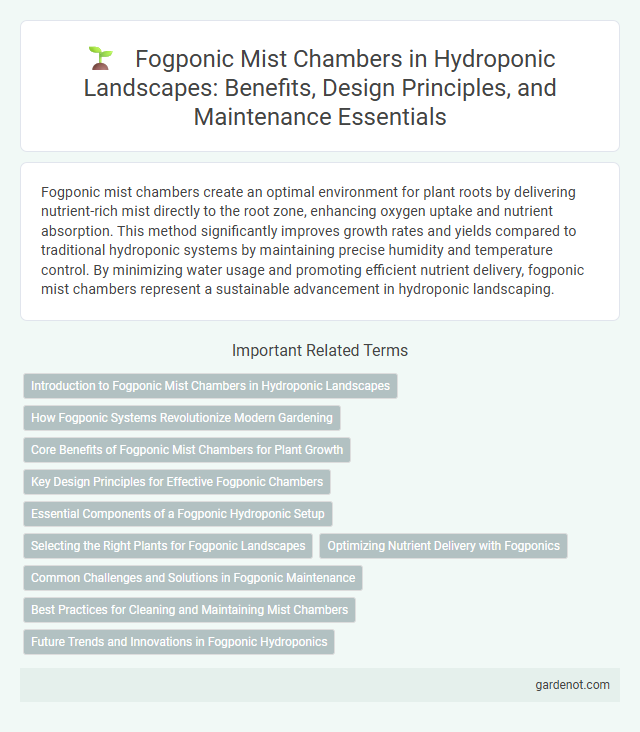Fogponic mist chambers create an optimal environment for plant roots by delivering nutrient-rich mist directly to the root zone, enhancing oxygen uptake and nutrient absorption. This method significantly improves growth rates and yields compared to traditional hydroponic systems by maintaining precise humidity and temperature control. By minimizing water usage and promoting efficient nutrient delivery, fogponic mist chambers represent a sustainable advancement in hydroponic landscaping.
Introduction to Fogponic Mist Chambers in Hydroponic Landscapes
Fogponic mist chambers enhance hydroponic landscapes by delivering fine nutrient-rich mist directly to plant roots, maximizing oxygen absorption and nutrient uptake. These chambers utilize advanced atomization technology to create a controlled environment that promotes rapid root growth and increases overall plant health. Incorporating fogponic systems in hydroponics leads to higher yields and more efficient water and nutrient usage compared to traditional methods.
How Fogponic Systems Revolutionize Modern Gardening
Fogponic systems revolutionize modern gardening by utilizing nutrient-rich mist to deliver oxygen and moisture directly to plant roots, enhancing growth rates and nutrient absorption efficiency. The fogponic mist chamber creates an optimal microenvironment that maximizes root exposure while minimizing water usage, making it ideal for urban and vertical farming setups. This precision-based technology fosters healthier plants with faster yields, transforming traditional hydroponic practices and supporting sustainable agriculture advancements.
Core Benefits of Fogponic Mist Chambers for Plant Growth
Fogponic mist chambers deliver ultra-fine nutrient mist directly to plant roots, enhancing oxygenation and nutrient absorption for accelerated growth. This method promotes higher yields and healthier plants by maintaining optimal moisture levels without waterlogging. Energy-efficient and space-saving, fogponic systems reduce water use by up to 90% compared to traditional soil cultivation.
Key Design Principles for Effective Fogponic Chambers
Fogponic mist chambers require precise control of droplet size, ideally between 5 to 30 microns, to maximize nutrient absorption and oxygen delivery to plant roots. The chamber must maintain optimal humidity and temperature levels, typically around 95% humidity and 20-25degC, to support root health and prevent fungal growth. Materials used should be resistant to corrosion and easy to sterilize, ensuring a contaminant-free environment for consistent plant growth.
Essential Components of a Fogponic Hydroponic Setup
A Fogponic mist chamber requires critical components such as high-frequency ultrasonic foggers that create fine nutrient-laden mist, ensuring optimal root exposure and oxygenation. A sealed mist chamber constructed from durable, non-toxic materials maintains humidity and prevents nutrient loss while allowing adequate airflow for plant roots. Precision nutrient reservoirs with pumps and timers regulate mist delivery, providing consistent hydration and nutrient absorption essential for plant growth in fogponic hydroponics.
Selecting the Right Plants for Fogponic Landscapes
Selecting the right plants for fogponic landscapes involves choosing species with fine root systems that can efficiently absorb the nutrient-rich mist in Fogponic mist chambers. Epiphytes, orchids, ferns, and certain leafy greens thrive due to their natural adaptation to high humidity and minimal soil requirements. Optimizing plant selection enhances growth rates and nutrient uptake, maximizing the effectiveness of Fogponic systems in controlled environment agriculture.
Optimizing Nutrient Delivery with Fogponics
Fogponic mist chambers enhance nutrient delivery by atomizing nutrient-rich solutions into ultra-fine mist droplets, allowing plant roots to absorb nutrients and oxygen more efficiently than traditional hydroponic systems. This optimized nutrient delivery maximizes root surface area exposure, promoting faster growth rates and higher yields. Controlled environmental parameters within the mist chamber also reduce nutrient waste and improve overall plant health in hydroponic landscapes.
Common Challenges and Solutions in Fogponic Maintenance
Fogponic mist chambers often face challenges such as nozzle clogging, inconsistent mist distribution, and nutrient solution contamination, which can hinder plant growth. Regular cleaning of mist nozzles, using high-quality filtered water, and maintaining sterile reservoir conditions help ensure optimal mist delivery and prevent system blockages. Implementing automated monitoring systems for nutrient levels and chamber humidity enhances maintenance efficiency and promotes healthy root development in hydroponic setups.
Best Practices for Cleaning and Maintaining Mist Chambers
Regular cleaning of Fogponic mist chambers prevents mineral buildup and bacterial growth, ensuring optimal nutrient delivery for hydroponic plants. Use a mild acid solution, such as diluted vinegar or citric acid, to dissolve residues without damaging components, followed by thorough rinsing with clean water. Inspect mist nozzles daily for clogs and replace worn parts promptly to maintain consistent mist quality and system efficiency.
Future Trends and Innovations in Fogponic Hydroponics
Fogponic mist chamber technology is rapidly evolving with advancements in ultra-fine mist atomization and nutrient delivery precision, enhancing plant growth efficiency and resource conservation. Integration of AI-driven sensors and automated climate controls is enabling real-time optimization of fog density, nutrient concentration, and environmental parameters, fostering sustainable urban agriculture. Emerging materials with antimicrobial properties and energy-efficient mist generators are poised to revolutionize large-scale fogponic systems, promoting scalability and reduced operational costs.
Fogponic mist chamber Infographic

 gardenot.com
gardenot.com